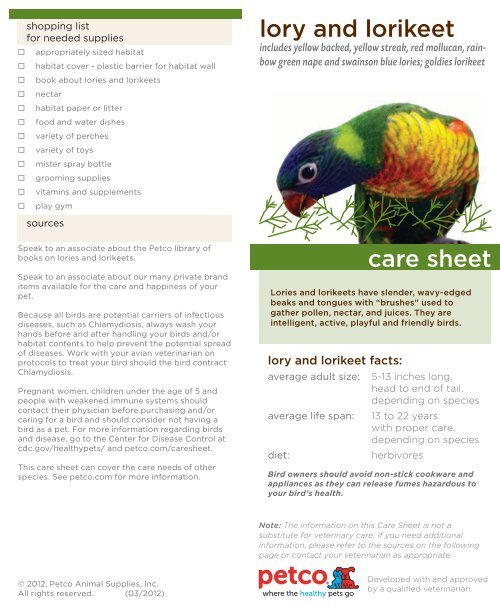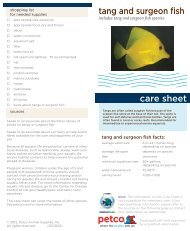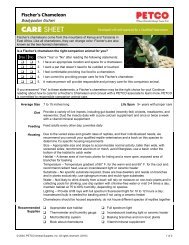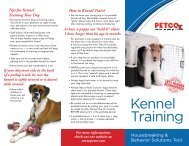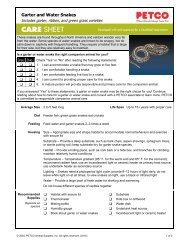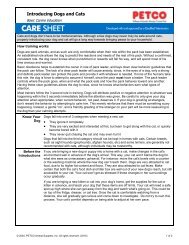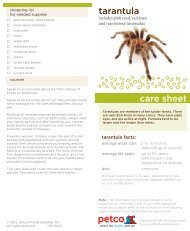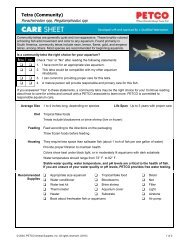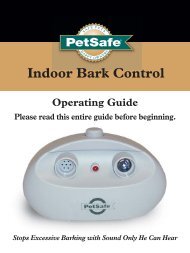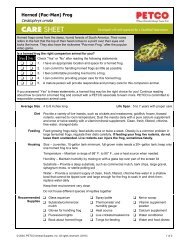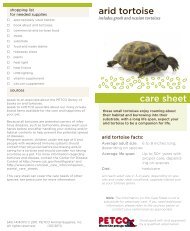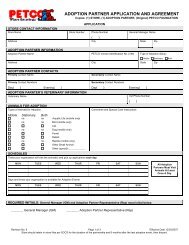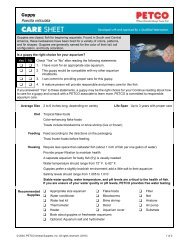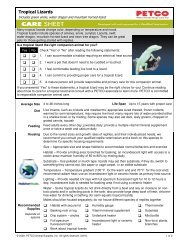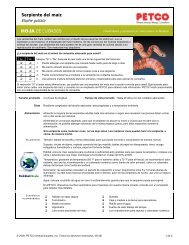You also want an ePaper? Increase the reach of your titles
YUMPU automatically turns print PDFs into web optimized ePapers that Google loves.
shopping list<br />
for needed supplies<br />
appropriately sized habitat<br />
habitat cover - plastic barrier for habitat wall<br />
book about lories <strong>and</strong> <strong>lorikeet</strong>s<br />
nectar<br />
habitat paper or litter<br />
food <strong>and</strong> water dishes<br />
variety of perches<br />
variety of toys<br />
mister spray bottle<br />
grooming supplies<br />
vitamins <strong>and</strong> supplements<br />
play gym<br />
sources<br />
Speak to an associate about the <strong>Petco</strong> library of<br />
books on lories <strong>and</strong> <strong>lorikeet</strong>s.<br />
Speak to an associate about our many private br<strong>and</strong><br />
items available for the <strong>care</strong> <strong>and</strong> happiness of your<br />
pet.<br />
Because all birds are potential carriers of infectious<br />
diseases, such as Chlamydiosis, always wash your<br />
h<strong>and</strong>s before <strong>and</strong> after h<strong>and</strong>ling your birds <strong>and</strong>/or<br />
habitat contents to help prevent the potential spread<br />
of diseases. Work with your avian veterinarian on<br />
protocols to treat your bird should the bird contract<br />
Chlamydiosis.<br />
Pregnant women, children under the age of 5 <strong>and</strong><br />
people with weakened immune systems should<br />
contact their physician before purchasing <strong>and</strong>/or<br />
caring for a bird <strong>and</strong> should consider not having a<br />
bird as a pet. For more information regarding birds<br />
<strong>and</strong> disease, go to the Center for Disease Control at<br />
cdc.gov/healthypets/ <strong>and</strong> petco.com/<strong>care</strong><strong>sheet</strong>.<br />
This <strong>care</strong> <strong>sheet</strong> can cover the <strong>care</strong> needs of other<br />
species. See petco.com for more information.<br />
© 2012, <strong>Petco</strong> Animal Supplies, Inc.<br />
All rights reserved. (03/2012)<br />
<strong>lory</strong> <strong>and</strong> <strong>lorikeet</strong><br />
includes yellow backed, yellow streak, red mollucan, rainbow<br />
green nape <strong>and</strong> swainson blue lories; goldies <strong>lorikeet</strong><br />
<strong>care</strong> <strong>sheet</strong><br />
Lories <strong>and</strong> <strong>lorikeet</strong>s have slender, wavy-edged<br />
beaks <strong>and</strong> tongues with “brushes” used to<br />
gather pollen, nectar, <strong>and</strong> juices. They are<br />
intelligent, active, playful <strong>and</strong> friendly birds.<br />
<strong>lory</strong> <strong>and</strong> <strong>lorikeet</strong> facts:<br />
average adult size: 5-13 inches long,<br />
head to end of tail,<br />
depending on species<br />
average life span: 13 to 22 years<br />
with proper <strong>care</strong>,<br />
depending on species<br />
diet: herbivores<br />
Bird owners should avoid non-stick cookware <strong>and</strong><br />
appliances as they can release fumes hazardous to<br />
your bird’s health.<br />
Note: The information on this Care Sheet is not a<br />
substitute for veterinary <strong>care</strong>. If you need additional<br />
information, please refer to the sources on the following<br />
page or contact your veterinarian as appropriate.<br />
Developed with <strong>and</strong> approved<br />
by a qualified veterinarian.
<strong>care</strong> <strong>sheet</strong><br />
diet<br />
A well-balanced <strong>lory</strong> <strong>and</strong> <strong>lorikeet</strong><br />
diet consists of:<br />
• High quality commercial necter<br />
or specialized pellet diets,<br />
supplemented with vegetable<br />
<strong>and</strong> fruit baby food <strong>and</strong> finely<br />
chopped vegetables <strong>and</strong> fruits;<br />
small amounts of fortified seeds<br />
• Clean, fresh, filtered, chlorinefree<br />
water, changed daily.<br />
• Do not feed birds avocado,<br />
fruit seeds, chocolate, caffeine<br />
or alcohol as these can cause<br />
serious medical conditions.<br />
Avoid sugar <strong>and</strong> high fat treats.<br />
feeding<br />
Things to remember when feeding<br />
your <strong>lory</strong> <strong>and</strong> <strong>lorikeet</strong>:<br />
• Fresh food <strong>and</strong> water should<br />
always be available.<br />
• Vegetables <strong>and</strong> fruits not eaten<br />
within a few hours should be<br />
discarded.<br />
• Remember, treats should not<br />
exceed 10% of total food intake.<br />
housing<br />
• Lories <strong>and</strong> Lorikeets acclimate<br />
well to average household<br />
temperatures, not to exceed<br />
80°F; be cautious of extreme<br />
temperature changes. The<br />
habitat should be placed off the<br />
red flags<br />
• beak swelling or<br />
accumulations<br />
• fluffed, plucked, or<br />
soiled feathers<br />
• sitting on floor of<br />
habitat<br />
• wheezing or coughing<br />
<strong>lory</strong> <strong>and</strong> <strong>lorikeet</strong><br />
includes yellow backed, yellow streak, red mollucan,<br />
rainbow green nape <strong>and</strong> swainson blue lories; goldies <strong>lorikeet</strong><br />
floor in an area that is well-lit<br />
<strong>and</strong> away from drafts.<br />
• A habitat approximately 24”W<br />
x 24”D x 30”H, with metal<br />
bars spaced no greater than<br />
1/2” apart, makes a good<br />
home for one <strong>lory</strong> or lorkieet.<br />
A flight habitat is strongly<br />
recommended. It is best to<br />
provide the largest habitat<br />
possible.<br />
• Perches should be at least<br />
4” long <strong>and</strong> 1/2” in diameter;<br />
a variety of perch sizes to<br />
exercise feet <strong>and</strong> help prevent<br />
arthritis is recommended.<br />
• A metal grate over the<br />
droppings tray will keep the<br />
bird away from droppings; line<br />
the droppings tray with habitat<br />
paper or appropriate substrate<br />
for easier cleaning. To avoid<br />
contamination, do not place<br />
food or water containers under<br />
perches.<br />
• Lories <strong>and</strong> <strong>lorikeet</strong>s can be<br />
kept alone, but do enjoy<br />
the company of other birds.<br />
Different types of birds should<br />
not be housed together.<br />
• Lories <strong>and</strong> <strong>lorikeet</strong>s should<br />
be socialized daily by the pet<br />
parent or kept in pairs to bond<br />
with each other.<br />
normal<br />
behavior<br />
• Affectionate birds that enjoy<br />
the company of birds in<br />
• runny or discolored<br />
stools<br />
• favoring one foot<br />
• eye or nasal discharge<br />
• red or swollen eyes<br />
• loss of appetite<br />
If you notice any of these signs, please contact your<br />
exotic animal veterinarian.<br />
nearby habitats, but should<br />
be kept alone.<br />
• Need to be kept occupied by<br />
providing daily attention <strong>and</strong><br />
a variety of toys.<br />
• Nectar diet causes runny<br />
stools; this is normal <strong>and</strong> can<br />
be messy.<br />
• Provide foraging toys, which<br />
provide important mental<br />
stimulation.<br />
• Ensure toys are strongly<br />
attached as they can unscrew<br />
c-clamps, which can cause<br />
injury.<br />
habitat<br />
maintenance<br />
• Clean <strong>and</strong> disinfect the<br />
habitat <strong>and</strong> perches regularly;<br />
replace substrate or habitat<br />
liner two to three times<br />
weekly or more often as<br />
needed.<br />
• Replace perches, dishes, <strong>and</strong><br />
toys when worn or damaged;<br />
rotate new toys into the<br />
habitat regularly.<br />
• Ensure that there are no<br />
habitat parts or toys with<br />
lead, zinc or lead-based<br />
paints or galvanized parts<br />
as these can cause serious<br />
medical issues if ingested by<br />
your bird.<br />
• Do not use a lot of cleaning<br />
common health issues<br />
Developed with <strong>and</strong> approved<br />
by a qualified veterinarian.<br />
agents around your bird as<br />
the fumes can be harmful.<br />
It is recommended to use a<br />
natural cleaning product.<br />
grooming<br />
& hygiene<br />
• Provide filtered, chlorine-free,<br />
lukewarm water regularly for<br />
bathing; remove the water<br />
when done. As an alternative,<br />
mist the bird with water.<br />
• Clipping flight feathers is not<br />
necessary, but when done<br />
correctly it can help prevent<br />
injury or escape; consult an<br />
avian veterinarian on what is<br />
best for your bird.<br />
• Nails should be trimmed by<br />
a qualified person to prevent<br />
injury to the bird.<br />
signs of a<br />
healthy animal<br />
• Active, alert, <strong>and</strong> sociable<br />
• Eats <strong>and</strong> drinks throughout<br />
the day<br />
• Dry nares <strong>and</strong> bright, dry eyes<br />
• Beak, legs <strong>and</strong> feet normal in<br />
appearance<br />
• Clean, dry vent<br />
• Smooth, well-groomed feathers<br />
Health Issue Symptoms or Causes Suggested Action<br />
chlamydiosis appetite loss, fluffed feathers, seek immediate avian<br />
nasal discharge. .<br />
veterinary attention.<br />
psittacine beak abnormal feather color, seek immediate avian<br />
<strong>and</strong> feather feather loss, beak<br />
veterinary attention.<br />
disease abnormalities.


